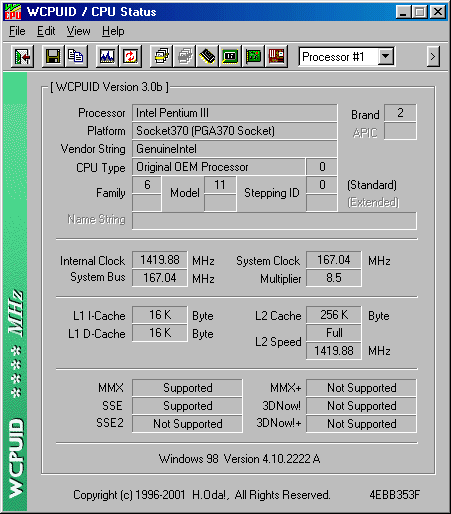HOT! An Early Look At The New Pentium III (Tualatin or Coppermine-T?)
When?
Mike Magee has just reported that it will take quite a bit longer than expected until Daddy Craig will release the little 'Tualatins' out to the performance-hungry Pentium III fans. Many of us are wondering why, and what the fuss with the next Pentium III is about anyway. For the majority of performance freaks the Pentium III is slowly disappearing already. Behold! As much as Pentium 4 might be hyped and marketed, the majority of processor sales is still dominated by Pentium III and once this processor comes at higher clock speeds, it can easily threaten the miraculous Pentium 4. Maybe Intel itself is surprised to see how well Tualatin actually scales and runs.
The Platform - MSI's 815 EPT Pro Motherboard
There is - of course - a downside to the new Pentium III processor as well. It may have the same socket (Socket370) as the good old Coppermine, but it requires a different I/O-voltage and thus a different chipset. Right now, you need a new version of Intel's 815 chipset (i815 EP B-stepping) to run the new PIII. Current PIII-boards won't be able to host the new breed.
We were using MSI's brand-new 815 EPT Pro motherboard, which was able to accommodate our new found little processor just fine. The voltage required by our processor toddler was a mere 1.5 V and since it was an engineering sample, the multiplier could be altered, though only to less than the x8.5 that are required for 1.13 GHz (at 133 MHz FSB). When we raised the multiplier to anything higher than x8.5 (which is absolutely possible with MSI's 815 EPT Pro), we always ended up running the little fellow at 533 MHz. This forced us to use tough overclocking measures, so that we tortured our little Tualatin or Coppermine-T at 166 MHz FSB and memory clock to reach an impressive 1419.88 MHz core clock.
MSI's 815 EPT Pro proved a highly stable platform, which allowed the 166 MHz FSB-overclocking without a glitch. The processor core voltage was raised to 1.6 V and the PC150 memory was adjusted to a 3-3-3-7/9 setting to ensure reliable operation. It gave me a warm and fuzzy feeling when I was finally able to witness a Pentium III finishing BAPCo's Sysmark at a core clock way higher than the previous 'Coppermine-limit' of 1066 MHz. I had not been as lucky with Intel's first Pentium 1.13 GHz processor last year that Intel finally retracted. Now it's time to congratulate Intel for finally managing this speed and I won't go on too much about the fact that it 'only' took some 10 months to make its promise come true.
Future Pentium III Also With 512 kB Second Level Cache
As faithful, though not always believing, readers of Mike Magee's TheInquirer, we are fully aware of the fact that a fellow Taiwanese hardware website that publishes in traditional Chinese spelling (BIG5) has got its hands on a Pentium III 1.13 GHz with 512 kB second-level cache. This is a clear sign that Intel will have two different versions of new-age Pentium III's, once it decides to bless the public with these processors. We would like to express our disappointment that our baby-processor is only equipped with the traditional 256 kB L2-cache. We'll try to grow a bit more L2-cache, but it will take a while and a lot of TLC.
Technical Specs?
We have not been briefed by Intel about the exact innards of our little processor discovery, so we can't give you a technology rundown on it as well. You will see however, that its performance is only slightly better than that of a Coppermine at the same core clock, which suggests that Tualatin/Coppermine-T received only minor architectural modifications.
Benchmark Setup
| Pentium III System | |
|---|---|
| Motherboard | MSI 815 EPT Pro, BIOS rev. 1.0 |
| Memory | 256 MB PC150 SDRAM |
| Athlon System | |
| Motherboard | MSI K7 Master MS-6341, BIOS 1.1 |
| Memory | 256 MB Infineon PC2100 DDR SDRAM 8-8-5-2-2-2-2 |
| Pentium 4 System | |
| Motherboard | Asus P4T, BIOS 1005 beta 1 |
| Memory | 256 MB Samsung PC800 RDRAM |
| Other System Components | |
| Hard Drive | IBM DTLA-307030, 7200 RPM, ATA100 |
| Graphics Card | NVIDIA GeForce2 Ultra, Driver 12.40 |
| Operating Systems | Microsoft Windows 98 SEMicrosoft Windows 2000 Professional Service Pack 2 |
| Screen Resolution | 1024x768x16x851280x1024x32x85 for SPECviewperf 6.1.2 |
Get Tom's Hardware's best news and in-depth reviews, straight to your inbox.

